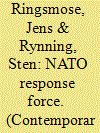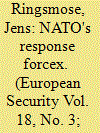| Srl | Item |
| 1 |
ID:
156088


|
|
|
|
|
| Summary/Abstract |
Military rapid response mechanisms are generally understood as troops that are on standby, ready to be deployed to a crisis within a short time frame. Yet, the overall track record of the existing multinational rapid response mechanisms within the European Union, the African Union, and North Atlantic Treaty Organization remains disappointing, and the United Nations does not even have a rapidly deployable capacity anymore. Meanwhile, despite that calls for the further development of these mechanisms are still being voiced politically, scholarly literature remains fragmented. This is problematic as many of the obstacles faced by these organizations are similar. This forum uniquely compares experiences from the four aforementioned organizations. Drawing on these insights, this introductory article identifies some key factors that hamper or enable the development and deployment of multinational rapid response mechanisms.
|
|
|
|
|
|
|
|
|
|
|
|
|
|
|
|
| 2 |
ID:
156090


|
|
|
|
|
| Summary/Abstract |
This article reviews the gloomy saga of the EU Battlegroups, focusing on four questions: Where do they come from? What do they look like? What have they been hindered by? And where do they go from here? It builds upon earlier findings in the literature and adds novel insights based on original data. In doing so, the article pays particular attention to the standby nations’ constant calculation of political and financial costs. It argues that recognizing these cost–benefit calculations allows for identifying the most crucial areas to be tackled to make the EU Battlegroups functional. In addition, the article stresses that these considerations play out in a setting wherein the Battlegroups are just one among many policy instruments available for rapid response.
|
|
|
|
|
|
|
|
|
|
|
|
|
|
|
|
| 3 |
ID:
096852


|
|
|
|
|
| Publication |
2009.
|
| Summary/Abstract |
At the Riga Summit in November 2006, NATO (North Atlantic Treaty Organization) declared the NATO Response Force (NRF) a fully operational capability. Yet only 8 months later - and behind closed doors - the Alliance's military authorities rescinded the declaration as it became increasingly clear that member states were unwilling to make the necessary commitments to the force. To this day, the force has been a qualified failure: while many allies have benefited from participating in the NRF, lack of concrete troop commitments and disagreement as to the force's operational role have largely eroded its credibility. This could change with the allies' recent adoption of a revised NRF-construct. However, as NATO is still in a state of strategic confusion, the NRF is likely to continue to be different things to different nations.
|
|
|
|
|
|
|
|
|
|
|
|
|
|
|
|
| 4 |
ID:
085669


|
|
|
|
|
| Publication |
2008.
|
| Summary/Abstract |
The NRF and the EU BG were launched to enable NATO and the EU respectively to shed some of their Cold War roles and begin to incorporate new organisational functions as means to meet their members' needs in a changing global security environment. However, since their launch the two rapid reaction forces have both failed to fully consolidate. Our argument is that an examination of intra-NATO/EU contested identities at three levels (supra-state, state and sub-state) provides us with additional insights for the lack of success in consolidating the two sets of rapid reaction forces.
|
|
|
|
|
|
|
|
|
|
|
|
|
|
|
|